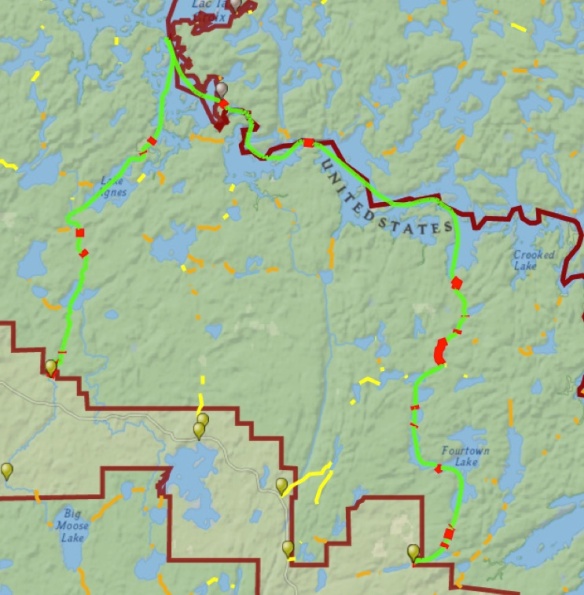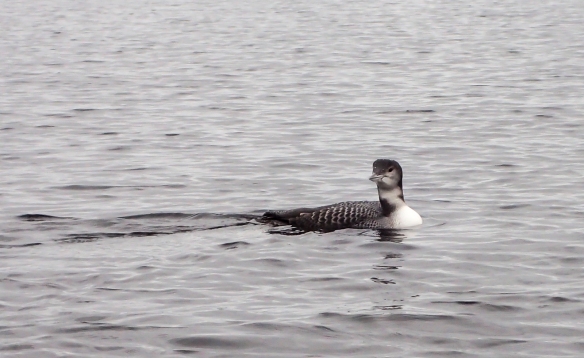There is magic in the feel of a paddle and the movement of a canoe, a magic compounded of distance, adventure, solitude, and peace. The way of a canoe is the way of the wilderness and of a freedom almost forgotten. It is an antidote to insecurity, the open door to waterways of ages past and a way of life with profound and abiding satisfactions. When a man is part of his canoe, he is part of all that canoes have ever known.
~Sigurd F. Olson
It has become a tradition of ours to go out into the wilds on our birthdays, and this year was one of the best. Several friends had talked about their trips to the Boundary Waters Canoe Area (BWCA) of Minnesota and whetted our appetite for such an adventure. We contacted Ely Outfitting Company and discussed options (I would recommend them). After a lot of planning and packing (thank you, Melissa, for all that hard work) the morning of my birthday found us eating breakfast at a wonderful little restaurant in downtown Ely, anxious to hit the water.
We chose the Moose River North to Mudro Lake route based on conversations with the outfitters and research online. It was deemed a bit more difficult, but is purportedly one the guide’s favorite routes due to the remoteness and diversity of habitats traversed. We would end up paddling about 40 miles and portaging 20 times for a distance of over 4 miles, with one portage being a little over a mile in length (something to look forward to…not). The outfitters provide a shuttle service so we left a car at the take-out and rode to the put-in with the shuttle driver. I admit to being surprised at the number of vehicles in both parking lots on a Thursday morning, but the BWCA is a very big place (over a million acres of designated wilderness) with over 1200 miles of canoe routes. We started with a half-mile portage from the road before we could drop the canoe in the water.
Our canoe was a Wenonah 18-footer made of Kevlar and weighing in at about 46 pounds (probably half the weight of my old 16-ft canoe at home). We packed our gear in two dry bag packs (each probably weighing 40+ pounds at our start), plus two smaller dry bags with essential items that we might need access to while paddling – rain gear, gloves, maps, binoculars, camera, snacks, water bottle, etc. After our first portage where we carried it all in one trip, we decided to use a shuttle system when portaging – one person takes the canoe, the other carries half the remaining gear about half-way and drops it. That person then returns to the start for the remainder of the gear. The canoe person drops the canoe at the other end and then comes back for the first load of gear that has been dropped halfway. That minimizes the amount of walking that we both had to do on each portage. Luckily, many portages are relatively short, but many are either rocky, steep, muddy, or some combination. But, once you do it a few times, it just becomes routine and is a chance to stretch your legs. Plus, it seemed each portage took us into a totally different habitat.
The outfitter had recommended campsites along the route but we were free to choose our own (you cannot reserve campsites, even though a permit system exists for entry into BWCA to limit the number of people in any one area). Each lake we traversed had one, or often, many more campsites, each with a US Forest Service installed fire grate and portable toilet.
Our main camp critter turned out to be a species of woodland mouse at almost every campsite (7:30 p.m. was reliably “mouse thirty” as they all seemed to come out about then each evening). We ended up hanging all of our gear in a bear bag each night to prevent any mischievous rodent chewing. Once you have a mouse or two run across the top of your tent at night, you become keenly aware of their potential. On our first morning we had a surprise visitor, a handsome black bear. I was digging in my bag for something when I heard Melissa say, “Oh my God, there is a bear”. Looking up, indeed, there was a healthy adult bear ambling into camp, nose in the air. The photo above was one of two I took with my iPhone before we yelled at the bear to move on, which it obligingly did. Other than that, camp life was very quiet. We soon got into our 8-day routine of paddling, portaging, setting up camp, eating some very good meals, and enjoying the incredible night sky.
One of our destinations was to some rock cliffs just across the border in Canada on Lac La Croix. This is one of many places in this wilderness adorned with rock paintings. These pictographs are believed to be several hundred years old, created by local native tribes paddling these waters in birch bark canoes.
Most of the paintings are reddish in color and lie beneath cliff overhangs, affording them some protection from the elements. Seeing these helped us realize the importance of these waters as a hunting, fishing, and trading route for many peoples over the past centuries, and made us even more appreciative to paddle in their long-gone wakes.
Our weather was extraordinary for this time of year with temperatures ranging from the 60’s each day to the 40’s at night (a bit colder the last two days with a strong wind). We had only one evening and morning with rain, so consider ourselves lucky. We saw at least one canoe every day but one, and had a lake to ourselves for two of the camps. Most campsites are incredibly beautiful with direct views onto the water and usually a large rock outcrop access for easy swimming (short, chilly swims this time of year). There is plenty of downed wood for small fires each night (and birch bark from downed trees is one of the best fire-starters imaginable). Plus, if you are so inclined, many of the lakes offer excellent fishing for walleye and pike. This really is a paddlers’ paradise.
The thing that really struck me was the quiet and feeling of solitude of the Northwoods. Of course we did hear the melancholy calls of loons on several lakes, but that is a soft, singular sound that seems to drift across the lake like an early morning fog. It is as much a part of this wilderness as are the clear cold waters or the pointed tops of the conifers. Once the call passes, the world seems to fall silent again. At each landing, we usually heard what must be considered the signature chatter of the Northwoods, the chirping of a red squirrel. They quickly moved on to gathering cones and mushrooms and the forest became quiet again. There was also the occasional call of a pileated woodpecker, the croak of a raven, or the tweet of some small song bird, but not the usual background noise of birds and insects I am accustomed to back home. Perhaps that is what makes the call of the loon all the more significant. And after dark, if the wind was not rustling (or blowing the last two nights) through the trees, there was virtually no sound (except for the one night a beaver decided to slap its tail in protest of our campfire on its shoreline).
I imagined that there must have been writers and naturalists inspired by this silence in such a vast expanse of wildness. Once I returned, I found the works of Sigurd F. Olson, an author, environmentalist, and long-time advocate for the protection of wilderness. He was a guide in what would become the BWCA and was instrumental in drafting the Wilderness Act of 1964. I found one of his quotes that spoke to the solitude and quiet of this magical place…
At times on quiet waters one does not speak aloud but only in whispers, for then all noise is sacrilege.
I leave you with a few other images from the trip. Because of portaging, I left most of my camera gear at home, so these are all taken with either an iPhone or an Olympus Tough point-and-shoot.

Our two days on the largest lakes were mercifully, and magically, as calm as any I have ever seen on the water

The northern version of “the wall” – international boundary marker in BWCA (I thought the first one I saw was some sort of can left behind by someone)

The quaking bog areas were among my favorite locations – if you venture out of your canoe, you literally can walk on trembling earth

Curtain Falls, one of the areas requiring a portage. We heard this falls from about a mile away on a calm day on the water.
Life is good to those who know how to live. I do not ever hope to accumulate great funds of worldly wealth, but I shall accumulate something far more valuable, a store of wonderful memories. When I reach the twilight of life I shall look back and say I’m glad I lived as I did, life has been good to me.
~Sigurd F. Olson
Species seen or heard on trip:
Birds – Bald eagle (they welcomed us at every campsite); Red-tailed hawk, American kestrel, Merlin, Common Raven, American crow, Gray jay, Black-backed woodpecker (a new species for me); Northern flicker, Pileated woodpecker; Red-breasted nuthatch; Ruby-crowned kinglet; Black-capped chickadee; White-throated sparrow; Yellow-rumped warbler; Tennessee warbler; Belted kingfisher; Pied-billed grebe; Horned grebe; Common loon; Wood duck; Lesser scaup; Red-breasted merganser; Hooded merganser; Trumpeter swan; Canada goose; Ruffed grouse; American Golden Plover (a new species for us)
Mammals – River otter; Beaver; Black bear; Red squirrel; Chipmunk; Mouse (Deer or white-footed); Muskrat; Moose tracks
Reptiles and amphibians – Painted turtle; American toad; Bullfrog; Spring peeper; Garter snake





























Really enjoyed seeing/reading this post. Thank you.
Thanks.
I always wondered what that area was like – and thanks to you, now I know! You were lucky to have such wonderful weather and calm waters. Beautiful photos even without your “fancier” equipment. Happy Birthday!
Thanks. A beautiful place indeed.
Thank you for this, Mike. It makes me long for the days when I could hope to do a trip like that — and for the trips I made “When I reach the twilight of life I shall look back and say I’m glad I lived as I did, life has been good to me.” …and your article helps me remember.
Glad to help you remember. Good news is you live in a place that many would aspire to travel to and spend time in close to nature.
Yes. :<) As the quote says "…life has been good to me."
Thanks for the wonderful details on your trip! John and I would love to do that same trip in a couple years. Great information. We love your blog!!
Thanks, Wendy. It is a beautiful place. Looks like it could get “crowded” in summer so I recommend spring or fall. Hope all is ok down your way in spite of high waters.